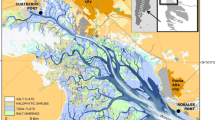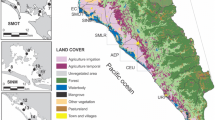Abstract
The uptake and distribution of lead (Pb) and cadmium (Cd) in thefreshwater crab, Potamonautes perlatus in the Eerste River,South Africa were studied seasonally over two years by comparingconcentrations in crabs, water and sediment in two localities, one upstream and one downstream from the town of Stellenbosch. Lead and cadmium concentrations in whole crabs of different sizeclasses as well as concentrations in various organs and tissues were determined by atomic absorption spectrometry. Data on physical, chemical and bacteriological features are also presented. The mean Zn concentration in the sediment of the downstream locality (77.5 ± 38.4 μg g-1) was significantly higher than in the less polluted upstream locality(44.7 ± 32.8 μg g-1) whilst the manganese concentration of the sediment was significantly higher in the upstream locality. The gonads (mean Pb 23.4, range 0.1-125.0 μg g-1; mean Cd 5.3, range 0.1-22.2 μg g -1) and carapace (mean Pb 23.4, range 0.7-327.6 μg g-1; mean Cd 4.0, range 0.4-18.5 μg g-1) contained thehighest concentrations of both metals irrespective of season orlocality. For both Pb and Cd significant differences (p < 0.05, Student's t-test) were found between the metal content of different organs. The gonads had the highest and the digestiveglands the lowest concentrations of both heavy metals.Results indicated that anthropogenic activities did not influencesediment and water concentrations significantly. Smaller crabs accumulated more lead and cadmium than larger crabs with all crabs having significantly higher concentrations than both waterand sediment. No significant differences in mean concentrationsof lead and cadmium in whole crabs or organs were found between the two localities. Although body loads for both metals did notreflect prevailing environmental levels of these metals reliably,the crabs may still be used to monitor bioavailability over time.
Similar content being viewed by others
References
Anderson, J.: 1974, ‘A study of the digestion of sediment by the HNO3-H2SO4 and the HNO3-HClprocedures’ At. Ab. N. 13, 31-32.
Anderson, R. V. and Brower, J. E.: 1978, ‘Patterns of trace metal accumulation in crayfish populations’ Bull. Environ. Contam. Toxicol. 20, 120-127.
Arkel, G. B. F.: 1979, ‘Aspects of the feeding and breeding biology of the Giant Kingfisher’ Ostrich 50, 176-181.
Barnard, K. H.: 1950, ‘Decriptive catalogue of South African decapod Crustacea’ Ann. S.A. Mus. 38, 179-194.
Du Preez, H. H., Steenkamp, V. E. and Schoonbee, H. J.: 1993, ‘Bioaccumulation of zinc and lead in selected tissues and organs of the freshwater crab, Potamonautes warreni’ Sci. Tot. Environ. Suppl., 469-478.
France, R. L.: 1987, ‘Calcium and trace metal composition of crayfish (Orconectes virilis) in relation to experimental lake acidification’ Can. J. Fish. Aquat. Sci. 44, 1078-113.
Griscom, S. B., Fisher, N. S. and Luoma, S. N.: 2000, ‘Geochemical influences on assimilation of sediment-bound metals in clams and mussels’ Environ. Sci. Technol. 34, 91-99.
Hill, M. P. and O'Keeffe, J. H.: 1992, ‘Some aspects of the ecology of the freshwater crab (Potamonautes perlatus Milne Edwards) in the upper reaches of the Buffalo river eastern Cape Province, South Africa’ S.A. J. Aquat. Sc. 18, 42-50.
Janczur, M., Kozlowski, J. and Laskowski, R.: 2000, ‘Optimal Allocation, Life History and Heavy Metal Accumulation: Dynamic Programming Model’ in J. Kamenga and R. Laskowski (eds), Demography in Ecotoxicology, Wiley, Chichester, UK, pp. 179-197.
Kempster, P. L., Hattingh, W. H. J. and Van Vliet, H. R.: 1980, ‘Summarized water quality criteria’ Dept. Environ. Aff. Tech. Rep. 108.
King, J. M.: 1981, ‘The distribution of invertebrate communities in a small South African river’ Hydrobiol. 83, 43-65.
Lewis, T. E. and McIntosh, A.W.: 1986, ‘Uptake of sediment-bound lead and zinc by the freshwater isopod Asellus cummunis at three different pH levels’ Arch. Environ. Contam. Toxicol. 15, 495-504.
Peijnenburg, W. J. G. M., Posthuma, L., Eijsackers, H. J. P. and Allen, H. E.: 1997, ‘A conceptual framework for implementation of bioavailability of metals for environmental management purposes’ Ecotoxicol. Environ. Saf. 37, 163-172.
Purves, M. G., Kruuk, H. and Nel, J. A. J.: 1994, ‘Crabs, Potamonautes perlatus in the diet of otter, Aonyx capensis and water mongoose Atilax paludinosus in a freshwater habitat in South Africa’ Z. Saügetierk. 59, 332-341.
Reinecke, A. J., Reinecke, S. A., Musibono, D. E. and Chapman, A.: 2000, ‘Transfer of lead (Pb) from earthworms to shrews (Myosorex varius)’ Archiv. Environ. Contam. Toxicol. 39, 392-397.
Roldan, B. M. and Shivers, R. R.: 1987, ‘The uptake and storage of iron and lead in cells of the crayfish (Orconectus propinquus) hepatopancreas and antennal gland’ Comp. Biochem. Physiol. C 86, 201-214.
Schulz, R., Peall, S. K. C., Dabrowski, J. M. and Reinecke, A. J.: 2001, ‘Current use insecticides, phosphates and suspended solids in the Lourens River, Western Cape, during the first rainfall event of the wet season’ Water S. A. 27, 65-70.
Snyman, R. G., Reinecke, A. J. and Nel, J. A. J.: 2002, ‘Uptake and distribution of copper in the freshwater crab, Potamonautes perlatus (Crustacea) in the Eerste River, South Africa’ African Zoology 81-89.
Van Eeden, P. H. and Schoonbee, H. J.: 1991, ‘Bio-accumulation of heavy metals by the freshwater crab Potamonautes warreni from a polluted wetland’ S. A. J. Wildl. Res. 21, 103-108.
Van Straalen, N. M. and Van Wensem, J.: 1986, ‘Heavy metal content of forest litter arthropods as related to body size and trophic level’ Environ. Poll. A, 42, 209-221.
Van Straalen, N. M. and Verkleij, J. A. C.: 1993, Leerboek Oecotoxicologie, V. U. Uitgeverij, Amsterdam, The Netherlands, pp. 423.
Watling, R. J. and Watling, H. R.: 1983, ‘Metal surveys in South African estuaries, VII, Bushmans, Kariega, Kowie and Great Fish Rivers’ Water S. A. 9, 66-70.
Author information
Authors and Affiliations
Corresponding author
Rights and permissions
About this article
Cite this article
Reinecke, A.J., Snyman, R.G. & Nel, J.A.J. Uptake and Distribution of Lead (Pb) and Cadmium (Cd) in the Freshwater Crab, Potamonautes Perlatus (Crustacea) in the Eerste River, South Africa. Water, Air, & Soil Pollution 145, 395–408 (2003). https://doi.org/10.1023/A:1023602121272
Issue Date:
DOI: https://doi.org/10.1023/A:1023602121272




